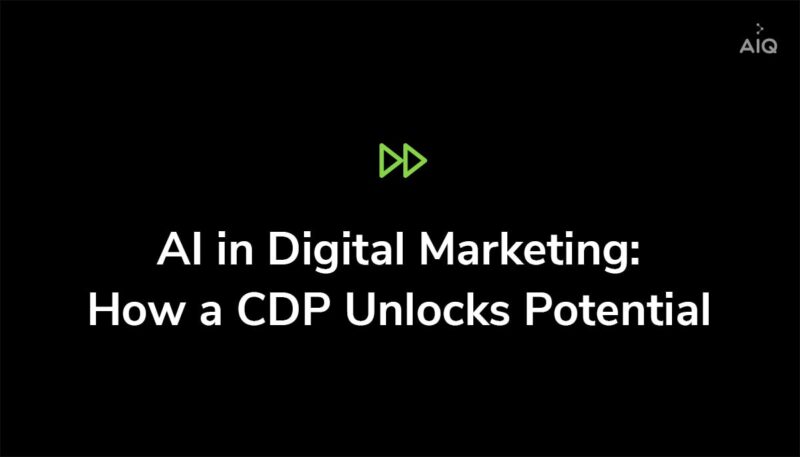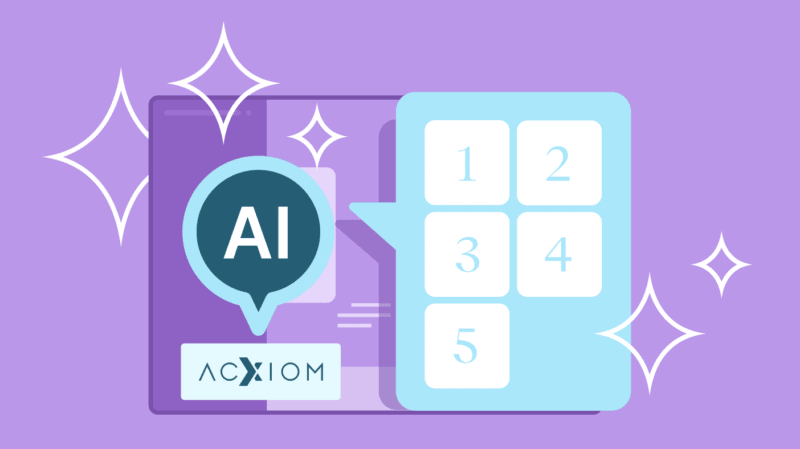AI in Digital Marketing: How a CDP Unlocks Potential

It is undisputed that, done right, AI in digital marketing can unlock enormous value for organizations. “Marketing leaders who stay focused on AI’s long-term transformational effect on marketing will gain sustainable competitive advantage,” writes Gartner.
As a result, the promise of artificial intelligence (AI) technologies in online marketing has led to massive investment by everyone from small business owners to Fortune 50 CMOs. However, it should be noted that buried in Gartner’s promise of success is a big “if.”
You can gain sustainable advantage—if you are able to “focus on AI’s long-term transformational effect.” And there is no guarantee you do so simply by throwing pre-baked AI algorithms at your current digital marketing strategies.
Fortunately, the right customer data platform (CDP) can provide a powerful foundation for the long-term transformational approach that Gartner prescribes. (Need more information on what is a CDP? Be sure to read our in depth article.)
Such a CDP can help you embed AI into a broad array of marketing activities, from programmatic advertising and social media to content marketing and customer service—and even into new frontiers from voice search to Google Home and beyond.
Still, buyers must beware. Many CDPs, hoping to capitalize on marketing trends, promise to speed the process of implementing AI with out-of-the-box AI technology. That may sound great, but as we explain below, out-of-the-box AI is in many ways a contradiction in terms. And it is definitely not the foundation that will have the “long-term, transformational effect on marketing” that Gartner describes.
Instead, the true power of AI in digital marketing comes when insights grow out of your own unique set of customer data, not someone else’s.
AI in Digital Marketing: Leading CDPs Connect AI-Driven Insight and Action
The right CDP will gather, organize and “refine” the fuel you need for AI technologies—i.e. all your rich, granular data about individual user behaviors and customer interactions. Data scientists no longer have to spend time and resources validating data quality and readying the data for analysis.
This is fundamental, but it is only a first step. As many early adopters of AI have learned, valuable insights end up sitting unused on the shelf, because marketers lack the ability to quickly access AI and machine learning (ML) findings or execute on them across channels.
To achieve a transformational effect on marketing, a CDP must provide three core AI capabilities:
- Out-of-the-box, human-in-the-loop AI. Pre-built AI can speed time-to-value, but business and analytics experts should have insight into generic AI algorithms—and be able to adjust them to their unique business goals.
- Fast, accurate big data access. Analysts and scientists should be able to access exactly the data they need, so they can begin AI modeling immediately without wasting a lot of time on traditional data wrangling.
- Seamless execution on AI insights. The CDP should be able to ingest AI-driven insights like customer scores into customer profiles instantly. And marketers must be able to deploy these insights immediately across any and all digital marketing strategies.
-
Why Out-of-the-Box AI Falls Short
The value of implementing AI lies in its ability to discover hidden insights from your unique set of customer data—and to provide extremely precise, granular guidance about individual customers. However, the traditional, resource-intensive approach to AI has been out of reach of many brands, forcing them to turn to out-of-the-box AI solutions.
Out-of-the-box AI is not in itself a bad thing. It can help you discover opportunities quickly. You do not need data scientists to build, train and refine algorithms. And because out-of-the-box models rely on only a limited set of data types, you accelerate data prep by focusing resources on a limited set of data types.
For these reasons, the out-of-the-box approach is very appropriate for certain brands—for example, startups that have collected a limited amount of customer data, or brands that lack the resources and expertise to build models using their own unique data.
However, the relative ease and lower cost of out-of-the-box AI does have a price. Pre-baked algorithms are based on insights that grow out of other people’s customers—and they may not apply to your own customers at all.
The Problem with Other People’s Data
Two brands may offer a very similar set of products and services, but this does not mean their customers share the same key attributes. As a result, out-of-the-box AI tends to be:
- Less precise. Customers from two different brands may have very different wants, needs and behavioral patterns, making findings less precise.
- Less relevant. While two brands may operate in the same sector, they may have very different business priorities and digital marketing strategies, requiring very different AI strategies.
- Less accurate. Different brands often measure and organize customer behaviors in different ways, so what seems like the same big data types ends up causing inaccurate insights.
- Less valuable. Some brands may gather extremely valuable datasets, but if that dataset is not part of the prebuilt, out-of-the-box model, its value is lost.
Inflexible AI Means Less Valuable Insights
We have seen the potential problems of AI algorithms based on another brand’s data. Now let’s consider some of the inherent limitations of inflexible generic algorithms themselves.
1) No insight into algorithms. Many times, “out-of-the-box” AI is short for “black-box” AI. In other words, you have no way to understand the weight an algorithm gives to different data types. As a result, marketers cannot use their own expertise to evaluate an algorithm’s effectiveness. And they cannot tweak algorithms to better serve your brand’s unique customer base, the specific products you offer, or the business goals you want to achieve.
1) A limited set of data types. Out-of-the-box AI models are generally limited to the sets of data that every brand routinely collects. Yes, these common data types can yield useful findings, but you may be leaving extremely valuable data sets out as well.
Let’s consider a generic churn model, which measures the risk that a potential customer will abandon the brand. It may not take into account the fact that churn risk can look very different for different products that you sell. If a customer has not purchased an item like diapers within the last 30 days, she could very likely be at risk. On the other hand, a customer who purchases a power drill may not be at risk after six or even 12 months.
3) Inability to learn and improve over time. Central to the promise of AI is that algorithms can measure their successes and failures and either adjust themselves automatically over time, or at least have the flexibility of letting an expert make the necessary adjustments. Very often, neither is possible with out-of-the-box AI.
For example, one subscription brand may find it useless trying to get their customers to upgrade their relationship. By contrast, a second subscription brand may attract the kinds of customers that make upselling a very rich opportunity. An out-of-the-box algorithm may identify valuable upsell opportunities for the second brand, while encouraging the first brand to waste precious resources marketing to low-quality targets.
Human-in-the-Loop AI
Instead of investing in black-box AI that offers no insight into algorithms and no ability to adjust them to your brand’s unique needs, look for a CDP that allows you to augment AI with human intelligence. AI is great at automating and scaling the grunt work associated with AI and machine language. But it has no capacity to set business goals or understand the particularities of your business, your offerings or your customer base.
According to McKinsey, a human-in-the-loop approach to AI provides a far sounder foundation on which to scale personalization.
III. How the Right CDP Dramatically Speeds Data Wrangling
In many ways, out-of-the-box AI developed as a reaction to the sheer amount of time and resources AI has traditionally required. Up to 80% of AI resources were devoted specifically to data wrangling—i.e. gathering and prepping data for the real work of AI.
Data wrangling is often shrouded in mystery, but it comes down to four essential tasks:
- Data gathering. The often hard work of hunting for data across multiple marketing, transactional and other systems.
- Data validation. Ensuring that data is accurate, complete and up-to-date, which can in itself be a very manual, labor-intensive process.
- Data combining. Organizing different data types so they can “talk” the same language—often the most challenging aspect of data wrangling, since it demands both technical and business expertise.
- Data selection. The ability of scientists to creatively combine different datasets in the search for effective AI algorithms, a process also known as “feature engineering.”
With the right CPD, you can speed and scale all these steps—and vastly improve the data scientists’ user experience in the process. Let’s consider the CDP capabilities that makes this possible:
- Instant data gathering.
Many businesses have gathered data into data lakes or enterprise data warehouses (EDWs). The problem is, data lakes tend to lack an organizing principle, turning data gathering into a painstaking process—even for data experts. Conversely, EDWs store data with such a rigid set of constraints, that only EDW experts can find the data required.
In response to these challenges, AI-friendly CDPs like ActionIQ’s platform are built with a schema-less database approach. Without getting too technical, these CDPs can ingest data from any source in its raw form at great speed and without complex data prep like ETL—and yet still provide the organizational structure to speed data gathering.
- Instant data validation.
Brands are always adding new types of data and data sources. However, once all that data has been gathered into a data lake or EDW, changes in data sources and formats remain invisible to data scientists. Undetected, these changes can lead to poor-quality results.
The right CDP avoids this risk by separating two distinct aspects of customer data that often get blurred in data lakes and EDWs: 1) specific business definitions of data types; and 2) the raw data provided by source systems. For example, the business definition of a valid purchase typically requires two different kinds of source data—purchase information and return information. However, this definition can over time, as the business evolves.
An AI-friendly CDP will keep the business definition of a valid purchase in a separate layer. That makes it easy to build in automatic alerts to let users know that there has been a change.
- Instant data combining.
AI algorithms inevitably require datasets generated by disparate systems which organize data in very different ways. Fortunately, AI-friendly CDPs can reduce all that potential complexity into two basic dimensions:
- Customer attributes. Data types that help define an individual customer’s identity, for example an email or a physical address, as well as demographic information (gender, neighborhood, age, etc.).
- Customer behavior. Granular interactions with your brand, from purchases and store visits to social media behaviors.
With this “logic” embedded into a CDP’s architecture, data scientists can instantly connect different data types without any further data manipulation.
- Select data on the fly.
Data scientists never know ahead of time which unique combination of datasets will provide valuable insights. They must be able to quickly and creatively combine a wide variety of datasets until they find the most valuable combination. This is the process known as feature engineering. The three capabilities above makes this work far faster and easier than in traditional environments. Data scientists have fast access to all relevant data, they can select lots of variables, and they can start testing different combinations right away.
This doesn’t just eliminate the costs and delays of traditional data wrangling. It also improves the user experience of data scientists, unleashing their creativity and productivity.
IV. How the Right CDP Turns Artificial Intelligence Into Tangible Action
Too often, marketers don’t have systems that make AI insights—e.g. predictive scores for individual customers—actionable across disconnected marketing execution systems. Let’s consider a specific example to understand this breakdown between intelligence and action.
Imagine that a subscription brand with a million customers wants to fight churn. After unleashing AI and/or machine learning (ML) tools on billions of rows of data, an AI algorithm calculates the churn risk across all one million customers. Then, the marketing team can create a special promotion that targets the 20,000 customers with the highest scores. But before they can create their campaign, marketing must enter a queue for tech experts to provide one of the following:
- A one-off spreadsheet with the target audience. Marketers often rely on tech resources to manually create a spreadsheet of these 20,000 customers, together with contact or other information needed to build a marketing campaign.
- Hard coding of the customer database. Alternatively, database engineers can hard-code, test and implement changes to an existing customer database, so that they can ingesting the new churn scores—a very labor-intensive process.
From Raw Scores to Rapid Campaign Execution with a CDP
An AI-friendly CDP removes these roadblocks to execution with three key capabilities:
1) Intelligent ingestion. Advanced CDPs are able to instantly and automatically associate raw churn scores with the matching customer profile without additional queries or coding. This is possible when the CDP reduces the complexity of customer data into the two essential categories, as noted above:
- Customer attributes, e.g. data that helps define an individual customer’s identity such as an email or a physical address.
- Customer behavior. Granular interactions with your brand, from purchases and store visits to—yes!—AI-generated customer scores.
2) Marketing self-service. When marketers have instant, interactive access to all their customer data—including timely churn scores—they act with much greater speed and agility than any one-off spreadsheet can provide. For example, they could instantaneously expand the target audience from the 20,000 customers at highest risk to 50,000 customers—or pivot and build a marketing campaign that capitalizes on the already-strong relationship with customers at the least risk.
Whatever their marketing strategy, they can then turn their target audience into highly targeted micro-segments, simply by leveraging key customer attributes and behaviors, from pages browsed and emails opened to zip code and estimated income.
3) Seamless cross-channel execution. Thanks to out-of-the-box and/or modern API integrations with all kinds of marketing channels (email, social media, etc.), the right CDP enables marketers to execute the resulting campaign across any channel, even via third-party providers. Advanced platforms like the ActionIQ CDP can even automate selection of optimal channel(s) based on customers’ historic interactions—and automate personalized content creation by appending content based on past behaviors, from past purchases to near-real-time browsing.
Are you ready to embed AI seamlessly and improve both customer experiences and marketing RIO, from email and social media campaigns all the way to sophisticated new frontiers from Google home to voice search?





